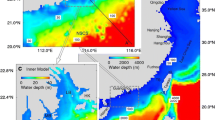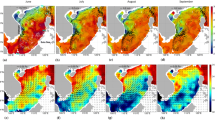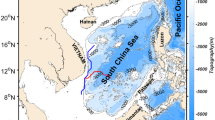Abstract
Surface geostrophic current derived from altimetry remote sensing data, and current profiles observed from in-situ Acoustic Doppler Current Profilers (ADCP) mooring in the northern South China Sea (NSCS) and southern South China Sea (SSCS) are utilized to study the kinetic and energetic interannual variability of the circulation in the South China Sea (SCS) during winter. Results reveal a more significant interannual variation of the circulation and water mass properties in the SSCS than that in the NSCS. Composite ananlysis shows a significantly reduced western boundary current (WBC) and a closed cyclonic eddy in the SSCS at the mature phase of El Niño event, but a strong WBC and an unclosed cyclonic circulation in winter at normal or La Niña years. The SST is warmer while the subsurface water is colder and fresher in the mature phase of El Niño event than that in the normal or La Niña years in the SSCS. Numerical experiments and energy analysis suggest that both local and remote wind stress change are important for the interannual variation in the SSCS, remote wind forcing and Kuroshio intrusion affect the circulation and water mass properties in the SSCS through WBC advection.
















Similar content being viewed by others
References
Atlas R et al (2011) A cross-calibrated, multiplatform ocean surface wind velocity product for meteorological and oceanographic applications. Bull Am Meteorol Soc 92:157–174
Cai S, Su J, Gan Z, Liu Q (2002) The numerical study of the South China Sea upper circulation characteristics and its dynamic mechanism, in winter. Cont Shelf Res 22:2247–2264
Chao S-Y, Shaw P-T, Wu S-Y (1996) El Nino modulation of the South China Sea circulation. Prog Oceanogr 38(1):51–93
Chen C, Wang G (2014) Interannual variability of the eastward current in the western South China Sea associated with the summer Asian monsoon. J Geophys Res. https://doi.org/10.1002/2014JC010309
Chen G, Xue H (2014) Westward intensification in marginal seas. Ocean Dyn 64:337–345
Cheng X, Qiu B, Cheng X, Qi Y, Du Y (2015) Intra‑seasonal variability of Pacific-origin sea level anomalies around the Philippine Archipelago. J Oceanogr. https://doi.org/10.1007/s10872-015-0281-9
Chern C-S, Sen J, Wang J (2010) Numerical study of mean flow patterns in the South China Sea and the Luzon Strait. Ocean Dyn 60:1047–1059
Chu PC, Edmons NL, Fan C et al (1999) Dynamical mechanisms for the South China Sea seasonal circulation and thermohaline variabilities. J Phys Oceanogr 29(11):2971–2989
Egbert GD, Erofeeva SY (2002) Efficient inverse modeling of barotropic ocean tides. J Atmos Ocean Tech 19(2):183–204
Egbert GD, Bennett AF, Foreman MGG (1994) TOPEX/Poseidon tides estimated using a global inverse model. J Geophys Res 99:24821–24852
Fang G, Fang W, Fang Y, Wang K (1998) A survey of studies on the South China Sea upper ocean circulation. Acta Oceanogr Taiwan 37(1):1–16
Fang G, Wei Z, Huang Q, Fang W (2002) Volume, heat and salt transports between the southern South China Sea and its adjacent waters, and their contribution to the Indonesian Throughflow. Oceanol Limnol Sin 33(3):296–302 (in Chinese, English abstract)
Fang G, Chen H, Wei Z, Wang Y, Wang X, Li C (2006) Trends and interannual variability of the South China Sea surface winds, surface height, and surface temperature in the recent decade. J Geophys Res 111:C11S16. https://doi.org/10.1029/2005JC003276
Gan J, Qu T (2008) Coastal jet separation and associated flow variability in the southwest South China Sea. Deep Sea Res I 55:1–19
Gan J, Li H, Curchitser EN, Haidvogel DB (2006) Modeling South China Sea circulation. Response to seasonal forcing regimes. J Geophys Res 111:C06034. https://doi.org/10.1029/2005JC003298
Haidvogel DB, Arango HG, Hedstrom K, Beckmann A. Malanotte-Rizzoli P, Shchepetkin AF (2000) Model evaluation experiments in the North Atlantic Basin: simulations in nonlinear terrain-following coordinates. Dyn Atmos Oceans 32:239–281
Hsin Y-C, Wu C-R, Chao S-Y (2012) An updated examination of the Luzon Strait transport. J Geophys Res 117:C03022. https://doi.org/10.1029/2011JC007714
Hu J, Kawamura H, Hong H, Qi Y (2000) A review on the currents in the South China Sea: seasonal circulation, South China Sea Warm Current and Kuroshio intrusion. J Oceanogr 56:607–624
Hu J, Zheng Q, Sun Z, Tai C (2012) Penetration of nonlinear Rossby eddies into South China Sea evidenced by cruise data. J Geophys Res 117:C03010. https://doi.org/10.1029/2011JC007525
Ivchenko VO, Treguier AM, Best SE (1997) A kinetic energy budget and internal instabilities in the Fine Resolution Antarctic Model. J Phys Oceanogr 27:5–22
Kim YY, Qu T, Jensen T, Miyama T, Mitsudera H, Kang H-W, Ishida A (2004) Seasonal and interannual variations of the North Equatorial Current bifurcation in a high resolution OGCM. J Geophys Res 109:C03040. https://doi.org/10.1029/2003JC002013
Li Y, Han W, Wilkin JL, Zhang WG, Arango H, Zavala-Garay J, Levin J, Castruccio FS (2014) Interannual variability of the surface summertime eastward jet in the South China Sea. J Geophys Res 119:7205–7228. https://doi.org/10.1002/2014JC010206
Liang XS (2014) Unraveling the cause-effect relation between time series. Phys Rev E 90:052150
Liu Z, Yang HJ, Liu QY (2001) Regional dynamics of seasonal variability of sea surface height in the South China Sea. J Phys Oceanogr 31(1):272–284
Liu Q, Feng M, Wang D (2011) ENSO-induced interannual variability in the southeastern South China Sea. J Oceanogr 67(1):127–133
Liu QY, Huang RX, Wang DX (2012) Implication of the South China Sea throughflow for the interannual variability of the regional upper-ocean heat content. Adv Atmos Sci 29(1):54–62. https://doi.org/10.1007/s00376-011-0068-x
Metzger EJ, Hurlburt HE (1996) Coupled dynamics of the South China Sea, the Sulu Sea and the Pacific Ocean. J Geophys Res 101:12331–12352
Qu T (2000) Upper layer circulation in the South China Sea. J Phys Oceanogr 30:1450–1460
Qu T, Kim YY, Yaremchuk M, Tozuka T, Ishida A, Yamagata T (2004) Can Luzon Strait transport play a role in conveying the impact of ENSO to the South China Sea? J Clim 17:3644–3657
Quan Q, Xue H, Qin H, Zeng X, Peng S (2016) Features and variability of the South China Sea western boundary current from 1992 to 2011. Ocean Dyn 66:795–810. https://doi.org/10.1007/s10236-016-0951-1
Shaw P-T, Chao S-Y (1994) Surface circulation in the South China Sea. Deep Sea Res I 4(1):1663–l683
Shchepetkin AF, McWilliams JC (2005) The Regional Ocean Modeling System: a split-explicit, free-surface, topography following coordinates ocean model. Ocean Model 9:347–404
Shu Y, Xue H, Wang D, Xie Q, Chen J, Li J, Chen R, He Y, Li D (2016) Observed evidence of the anomalous South China Sea western boundary current during the summers of 2010 and 2011. J Geophys Res 121:1145–1159. https://doi.org/10.1002/2015JC011434
Wang G, Su J, Chu PC (2003) Mesoscale eddies in the South China Sea observed with altimeter data. Geophys Res Lett 30(21):2121. https://doi.org/10.1029/2003GL018532
Wang C, Wang W, Wang D, Wang Q (2006a) Interannual variability of the South China Sea associated with El Nino. J Geophys Res 111:C03023. https://doi.org/10.1029/2005JC003333
Wang D, Liu Q, Huang RX, Du Y, Qu T (2006b) Interannual variability of the South China Sea throughflow inferred from wind data and an ocean data assimilation product. Geophys Res Lett 33:L14605. https://doi.org/10.1029/2006GL026316
Wang G, Chen D, Su J (2006c) Generation and life cycle of the dipole in the South China Sea summer circulation. J Geophys Res 111:C06002. https://doi.org/10.1029/2005JC003314
Wang Y, Fang G, Wei Z, Qiao F, Chen H (2006d) Interannual variation of the South China Sea circulation and its relation to El Niño, as seen from a variable grid global ocean model. J Geophys Res 111:C11S14. https://doi.org/10.1029/2005JC003269
Wang D, Xu H, Lin J, Hu J (2008) Anticyclonic eddies in the northeastern South China Sea during winter 2003/2004. J Oceanogr 64:925–935. https://doi.org/10.1007/s10872-008-0076-3
Wei J, Malanotte-Rizzoli P, Eltahir EAB, Xue P, Xu D (2014) Coupling of a regional atmospheric model (RegCM3) and a regional ocean model (FVCOM) over the Maritime Continent. Clim Dyn 43:1575–1594. https://doi.org/10.1007/s00382-013-1983-6
Wei J, Malanotte-Rizzoli P, Li M-T, Wang H (2016) Decomposition of thermal and dynamic changes in the South China Sea induced by boundary forcing and surface fluxes during 1970–2000. J Geophys Res 121:7953–7972. https://doi.org/10.1002/2016JC012078
Wu C-R, Chang C-WJ (2005) Interannual variability of the South China Sea in a data assimilation model. Geophys Res Lett 32:L17611. https://doi.org/10.1029/2005GL023798
Wu C-R, Hsin Y-C (2012) The forcing mechanism leading to the Kuroshio intrusion into the South China Sea. J Geophys Res 117:C07015. https://doi.org/10.1029/2012JC007968
Wu C-R, Shaw P-T, Chao S-Y (1998) Seasonal and interannual variations in the velocity field of the South China Sea. J Oceanogr 54:361–372
Wyrtki K (1961) Scientific results of marine investigations of the South China Sea and the Gulf of Thailand 1959–1961. Naga Report, vol 2. University of California, San Diego, pp 164–169
Xie L, Zheng Q, Tian J, Zhang S, Feng Y, Yi X (2016) Cruise observation of Rossby waves with finite wavelengths propagating from the Pacific to the South China Sea. J Phys Oceanogr 46(10):2897–2913
Xue H, Chai F, Pettigrew N, Xu D, Shi M, Xu J (2004) Kuroshio intrusion and the circulation in the South China Sea. J Geophys Res 109:C02017. https://doi.org/10.1029/2002JC001724
Yang H, Liu Q, Liu Z, Wang D, Liu X (2002) A general circulation model study of the dynamics of the upper ocean circulation of the South China Sea. J Geophys Res 107:C7, 3085
Yu L, Jin X, Weller RA (2008) Multidecade Global Flux Datasets from the Objectively Analyzed Air-sea Fluxes (OAFlux) Project: latent and sensible heat fluxes, ocean evaporation, and related surface meteorological variables. Woods Hole Oceanographic Institution, OAFlux Project Technical Report. OA-2008-01, p 64. Woods Hole. Massachusetts
Zeng L, Wang D, Chen J, Wang W, Chen R (2016) SCSPOD14, a South China Sea physical oceanographic dataset derived from in situ measurements during 1919–2014. Sci Data 3:160029. https://doi.org/10.1038/sdata.2016.29
Zhang M, von Storch H (2017) Toward downscaling oceanic hydrodynamics—suitability of a high-resolution OGCM for describing regional ocean variability in the South China Sea. Oceanologia. https://doi.org/10.1016/j.oceano.2017.01.001
Zheng Q, Fang G, Song YT (2006) Introduction to special section: dynamics and Circulation of the Yellow, East, and South China Seas. J Geophys Res 111:C11S01. https://doi.org/10.1029/2005JC003261
Zheng Q, Xie L, Zheng Z, Hu J (2017) Progress in research of mesoscale eddies in the South China Sea. Adv Mar Sci 35(20):131–158
Zhuang W, Qiu B, Du Y (2013) Low-frequency western Pacific Ocean sea level and circulation changes due to the connectivity of the Philippine Archipelago. J Geophys Res 118:6759–6773. https://doi.org/10.1002/2013JC009376
Zu T, Wang D, Gan J, Guan W (2014) On the role of wind and tide in generating variability of Pearl River plume during summer in a coupled wide estuary and shelf system. J Mar Sys 136:65–79. https://doi.org/10.1016/j.jmarsys.2014.03.005
Acknowledgements
We are grateful to the editor and anonymous reviewers for their valuable suggestions and comments which greatly help to improve the manuscript. We also thank Xiaopei Lin for his helpful discussion. We benefited from numerous data sets made freely available, including AVISO (http://www.aviso.altimetry.fr/en/data/data-access.html), TMISST (http://apdrc.soest.hawaii.edu/datadoc/trmm_tmi_mon.php), CCMP (http://www.remss.com/measurements/ccmp/), OAFlux (http://oaflux.whoi.edu/heatflux.html). The numerical simulation is supported by the high-performance computing division and Ms. Dandan Sui of the South China Sea Institute of Oceanology. This study is jointly supported by the Strategic Priority Research Program of the Chinese Academy of Sciences (XDA11010302, XDA11010304), the National Natural Science Foundation of China (41521005, 41476013, 41576002, 41576012, 41628601, 41776025). The Guangdong Natural Science Funds for Distinguished Yong Scholar (2014A030306049).
Author information
Authors and Affiliations
Corresponding author
Rights and permissions
About this article
Cite this article
Zu, T., Xue, H., Wang, D. et al. Interannual variation of the South China Sea circulation during winter: intensified in the southern basin. Clim Dyn 52, 1917–1933 (2019). https://doi.org/10.1007/s00382-018-4230-3
Received:
Accepted:
Published:
Issue Date:
DOI: https://doi.org/10.1007/s00382-018-4230-3




